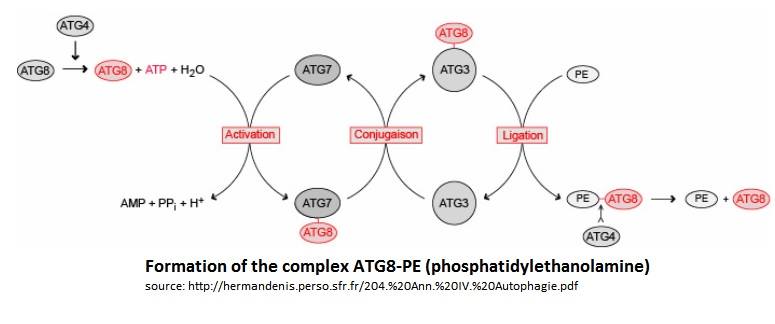Sandbox Reserved 1137
From Proteopedia
| Line 6: | Line 6: | ||
=== Cellular effects === | === Cellular effects === | ||
---- | ---- | ||
| - | The autophagy related proteins (Atg) are proteins which purpose is to help the parasite to survive and develop. Atg8 and Atg3 are both involved in the [https://en.wikipedia.org/wiki/Autophagy autophagy] process, by creating an [https://en.wikipedia.org/wiki/Autophagosome autophagosome] and then making it grow. The autophagosome can be compared to a [https://en.wikipedia.org/wiki/Vacuole vacuole] and absorbs the components of the cytoplasm (in a non specific way). When the growing phase (sporozoite) of the cell is over,in the case of ''Plasmodium falciparum'', the autophagy is launched by the cell in order to become erythrocytic-infective. This is the time when the cell starts its viral activity. Lysosomes then merge with the autophagosme to form the [https://en.wiktionary.org/wiki/autolysosome autolysosome]. Once this process is done, the autolysosome can complete its purpose : recycle the its content. In fact, all the molecules inside are degradated and their components (like aminoacids) are reused in order to synthetise viral proteins. | + | The autophagy related proteins (Atg) are proteins which purpose is to help the parasite to survive and develop. Atg8 and Atg3 are both involved in the [https://en.wikipedia.org/wiki/Autophagy autophagy] process, by creating an [https://en.wikipedia.org/wiki/Autophagosome autophagosome] and then making it grow. The autophagosome can be compared to a [https://en.wikipedia.org/wiki/Vacuole vacuole] and absorbs the components of the cytoplasm (in a non specific way). When the growing phase ([https://en.wikipedia.org/wiki/Apicomplexan_life_cycle sporozoite]) of the cell is over,in the case of ''Plasmodium falciparum'', the autophagy is launched by the cell in order to become erythrocytic-infective. This is the time when the cell starts its viral activity. Lysosomes then merge with the autophagosme to form the [https://en.wiktionary.org/wiki/autolysosome autolysosome]. Once this process is done, the autolysosome can complete its purpose : recycle the its content. In fact, all the molecules inside are degradated and their components (like aminoacids) are reused in order to synthetise viral proteins. |
=== Molecular effects === | === Molecular effects === | ||
---- | ---- | ||
Revision as of 20:47, 29 January 2016
| This Sandbox is Reserved from 15/12/2015, through 15/06/2016 for use in the course "Structural Biology" taught by Bruno Kieffer at the University of Strasbourg, ESBS. This reservation includes Sandbox Reserved 1120 through Sandbox Reserved 1159. |
To get started:
More help: Help:Editing |
Plasmodium falciparum Atg8 in complex with Plasmodium falciparum Atg3 peptide
| |||||||||||
References
1. Hain AU, Weltzer RR, Hammond H, Jayabalasingham B, Dinglasan RR, Graham DR, Colquhoun DR, Coppens I, Bosch J Structural characterization and inhibition of the plasmodium atg8-atg3 interaction. J.Struct.Biol. (2012) 180 p.551
2. Machiko Sakoh-Nakatogawa, Kazuaki Matoba, Eri Asai, Hiromi Kirisako, Junko Ishii, Nobuo N Noda, Fuyuhiko Inagaki, Hitoshi Nakatogawa & Yoshinori Ohsumi Atg12–Atg5 conjugate enhances E2 activity of Atg3 by rearranging its catalytic site Nature Structural & Molecular Biology 20, 433-439 (2013) doi :10.1083/nsmb.2527
3. Oliver H. Weiergräber, Jeannine Mohrlüder and Dieter Willbold Atg8 Family Proteins — Autophagy and Beyond, DOI: 10.5772/55647 Biochemistry, Genetics and Molecular Biology » "Autophagy - A Double-Edged Sword - Cell Survival or Death?", book edited by Yannick Bailly, ISBN 978-953-51-1062-0, Published: April 17, 2013 under CC BY 3.0 license.
4. Herman Denis, http://hermandenis.perso.sfr.fr/204.%20Ann.%20IV.%20Autophagie.pdf
5. Patrice Codogno Les gènes ATG et la macro-autophagie Med Sci (Paris). 2004 August; 20(8-9): 734–736. Published online 2004 August 15. doi: 10.1051/medsci/2004208-9734
6. Hain AU, Bartee D, Sanders NG, Miller AS, Sullivan DJ, Levitskaya J, Meyers CF, Bosch J. Identification of an Atg8-Atg3 protein-protein interaction inhibitor from the medicines for Malaria Venture Malaria Box active in blood and liver stage Plasmodium falciparum parasites. J Med Chem. 2014 Jun 12;57(11):4521-31. doi: 10.1021/jm401675a. Epub 2014 May 19
7. Masaya Yamaguchi, Nobuo N. Noda, Hitoshi Nakatogawa, Hiroyuki Kumeta, Yoshinori Ohsumi and Fuyuhiko Inagaki Autophagy-related Protein 8 (Atg8) Family Interacting Motif in Atg3 Mediates the Atg3-Atg8 Interaction and Is Crucial for the Cytoplasm-to-Vacuole Targeting Pathway. The Journal of Biological Chemistry vol.28. 2010, September 17. doi:10.1074/jbc.M110.11367
8. Hain AU1, Weltzer RR, Hammond H, Jayabalasingham B, Dinglasan RR, Graham DR, Colquhoun DR, Coppens I, Bosch J. Structural characterization and inhibition of the Plasmodium Atg8-Atg3 interaction. J Struct Biol. 2012 Dec;180(3):551-62. doi: 10.1016/j.jsb.2012.09.001. Epub 2012 Sep 13.PMID:22982544
9. Machiko Sakoh-Nakatogawa, Kazuaki Matoba, Eri Asai, Hiromi Kirisako, Junko Ishii, Nobuo N Noda, Fuyuhiko Inagaki, Hitoshi Nakatogawa & Yoshinori Ohsumi. Atg12–Atg5 conjugate enhances E2 activity of Atg3 by rearranging its catalytic site. Nature Structural & Molecular Biology. 2013 February. doi:10.1038/nsmb.2527

